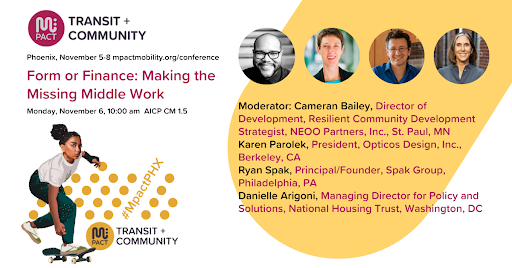Transit Oriented Development: Form or Finance
In 2019, also known as “the before times,” I helped to organize a session for the Rail~Volution (now Mpact) conference about zoning. It was focused on lessons-learned as we heard from cities who had implemented their second round of code changes to support transit-oriented development. The panel included a planner from Minneapolis, who awed us with the story of how the city’s new comprehensive plan, which removed a number of restrictions on land use and parking, came to be.
Fast forward to 2023 and Minneapolis 2040 has been challenged in court. The letter of the challenge is environmental, claiming that a plan calling for new development must be accountable for assessing the impacts of the same. However, the spirit of the challenge appears to be good, old fashioned NIMBY (not in my back yard). The most widely known change brought by Minneapolis 2040 was the elimination of exclusive single-family zoning districts.
To be clear, people often take shortcuts when talking about the idea of allowing more types of housing in historically single-family districts; they sometimes refer to it as “eliminating single-family zoning,” which can confuse allowing diversity for doing away with stand-alone homes.
The movement for more variety in our housing stock comes in multiple shapes and sizes. For example, some seek to allow accessory dwelling units (ADUs) and four-plexes while others advocate for mixed-use and height bonuses. Motivations vary as well; while some want to protect existing homeowners from displacement, for example, others may want to create better access to goods and services.
One well-defined effort to create housing diversity is the movement for the Missing Middle. As discussed in our previous post, Missing Middle has been popularized as a typology, a segment of housing types that have been largely eliminated from the urban landscape due to restrictive zoning, and these types are needed to provide options that can accommodate a wider range of lifestyles and incomes.
As outlined in “Finding Opportunities in Legacy Cities,” policy alone is not a sufficient solution to address housing diversity for incomes. There are established mechanisms to enable affordable housing but they are limited, both in quantity and who they help. As noted in our post, middle income housing remains a gap.
This is the starting point for the discussion that will take place at the session that I organized for this year’s Mpact conference: Form or Finance: Making the Missing Middle Work. We will bring together policy experts and development implementers to talk about what combinations of policy and financing tools have gotten projects across the finish line and what tools are still needed to help communities achieve the full spectrum of housing affordability.
To ensure you get to read our latest stories, subscribe to our evolve insights newsletter.



